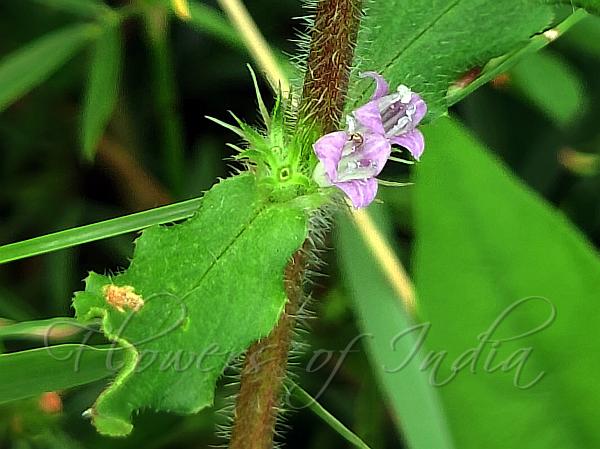|
| Shaggy Buttonweed |
|

|

|
|
|
|
Photo: |
Botanical name: Spermacoce hispida Family: Rubiaceae (Coffee family)
Synonyms: Borreria hispida, Spermacoce rigida, Spermacoce mutilata
Synonyms: Borreria hispida, Spermacoce rigida, Spermacoce mutilata
Shaggy Buttonweed is a annual or perennial herb,
prostrate to weakly rising up, up to 50 cm tall; stems hairy. Leaves
are stalkless to shortly stalked; leaf-stalk up to 4 mm, blade drying
papery to leathery, oblong-elliptic, obovate, or spoon-shaped, 1-3 x
0.5-1.5 cm, both surfaces hairy to rough bristly, hairy, base
wedge-shaped to blunt and usually long decurrent, margin often curled,
fringed with hairs, tip pointed, blunt, or rounded; secondary veins 2-4
pairs or not visible. Flowers are borne in leaf-axils, in clusters
0.5-1.5 cm in diameter, with 1-6 flowers per axil. Flowers are pink,
purple, or white, funnel-shaped, tube 2.5-4.5 mm, petals
elliptic-oblong, lanceshaped, or triangular, 1-1.8 mm. Sepal-cup is
hairy, sepals 4, linear-lanceshaped to narrowly triangular, 1-1.5 mm,
fringed with hairs. Bracts are linear or infrequently stipule-like, 1-5
mm. Capsules are ellipsoid to nearly spherical, 2.5-5 x 2.5-3.5 mm,
hairy. Shaggy Buttonweed is found in India, Himalayas, Indonesia,
Malaysia, Philippines, Sri Lanka, Vietnam, Australia.
Medicinal uses: According to the tribal
community in Kerala along the Western Ghats, the seeds of this plant
can cure internal injuries of nerves and kidneys, purify the blood,
shed markings of old age, and improve vitality.
According to the tribal
community in Kerala along the Western Ghats, the seeds of this plant
can cure internal injuries of nerves and kidneys, purify the blood,
shed markings of old age, and improve vitality.
Medicinal uses:
 According to the tribal
community in Kerala along the Western Ghats, the seeds of this plant
can cure internal injuries of nerves and kidneys, purify the blood,
shed markings of old age, and improve vitality.
According to the tribal
community in Kerala along the Western Ghats, the seeds of this plant
can cure internal injuries of nerves and kidneys, purify the blood,
shed markings of old age, and improve vitality. | Identification credit: Preetha P.S. | Photographed in Kollam, Kerala. |
• Is this flower misidentified? If yes,